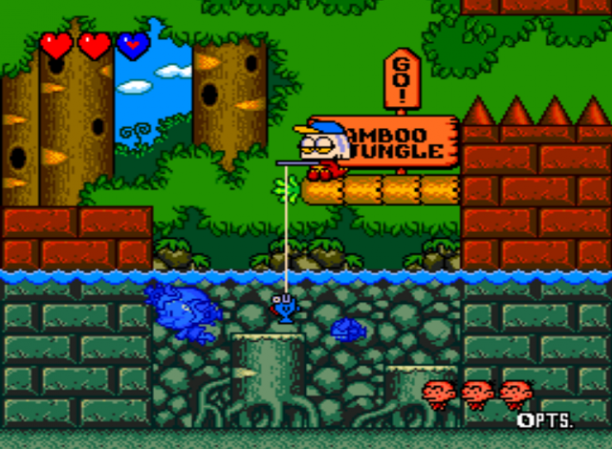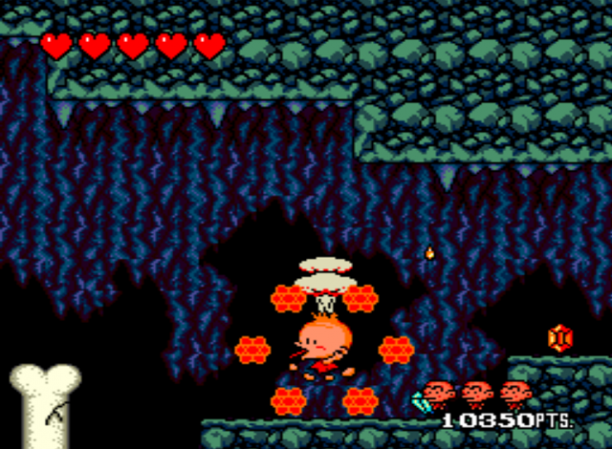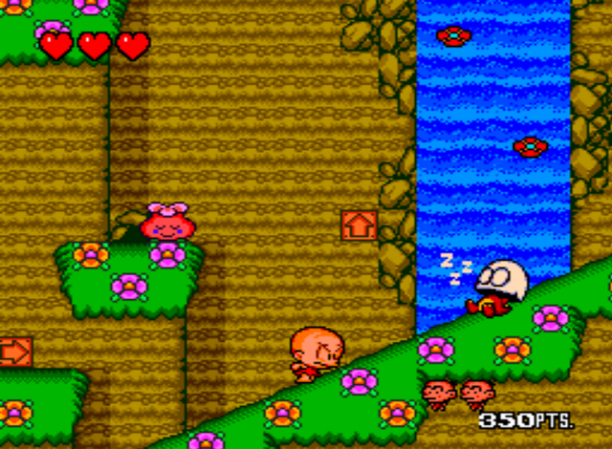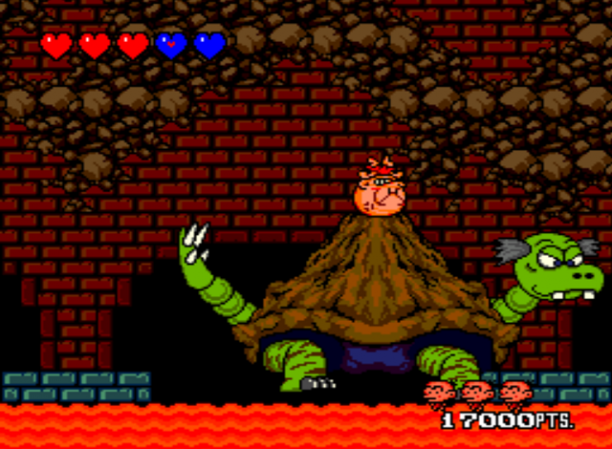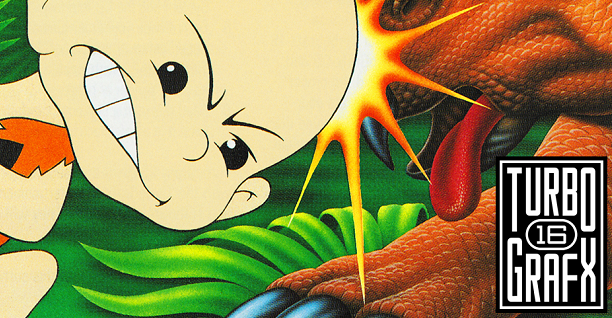
Pixel Gallery
Bonk’s Revenge
Retro Platforms: Game Boy, TurboGrafx-16
Platform Reviewed: TurboGrafx-16
When a giant dinosaur somehow manages to steal half of the freaking moon, it’s up to an unhealthily meat-obsessed and generally impatient caveman to save the day! It’s never really explained how the science for any of this makes sense, nor do we ever find out why the caveman’s ultimate rival is named after the pleasant act of salivation. In actuality, the story to Bonk’s Revenge is probably the game’s weakest element; it’s really just a basic excuse for Bonk to go on another quest to terrorize every living creature that dares to stand in his way. But in terms of level structure and overall gameplay, is Bonk’s Revenge a superior game to its predecessor? Are the controls notably improved, are there more gameplay mechanics, and is the overall presentation enhanced?
Graphics
This is exactly how a sequel should be made! Bonk’s Adventure already had a really pleasant color selection, and Bonk’s Revenge maintains that bright nature while also expanding on technical details. One of the more notable enhancements is with regards to level backgrounds: despite the continued lack of parallax scrolling, many level backgrounds have much higher complexities, such as forests having multiple depths of trees to give impressions of three-dimensional environments, temple interiors featuring columns in front of incomplete brick walls, skies being partially covered by distant bushes, factories containing distant lighting, and there are many other examples! Locations are varied too, such as a tropical setting that shifts from coastlines to pirate ships, snow levels with bluish underwater effects, and there’s a general pattern of blending earlier structures of humanity into prehistoric nature settings. Enemies also have environmental cosmetic details, such as some monsters wearing festive hats in winter sections, and bosses’ attacks complementing their lairs.
There are larger attempts to have settings affect the gameplay as well, with the most common being meteor-like perils that launch into the air before slowly raining down onto a stage; this encourages you to pay attention to setting-specific effects, which pleasantly gives the visual design a stronger presence. Partial visibility is another neat detail, such as Bonk moving through windowed trains from an outside perspective. Regarding animation, many effects from Bonk’s Adventure have been improved in terms of technical details: Bonk’s expressions have more specific visuals, transformations have more wackiness, and there are generally lots of humorous moments, such as Bonk being literally fished up or crushed into the shape of a crab. There’s no performance lag either, and the only visual criticism I can really give is that construction areas tend to feel too frequent; they’re also not as pleasant as raw nature settings, but that’s me being overly critical. Everything else checks out well!
Audio
One of my favorite things about Bonk’s Adventure was its simple yet incredibly cheerful music, and Bonk’s Revenge introduces tracks that somehow manage to be even livelier! Like before, the soundtrack largely consists of tribal themes that gradually build in complexity over time, and even when some of the tracks get intense, they always manage to provide that seriousness in an upbeat manner. Instruments complement their respective environments too: a volcanic area has a lower melody and alternating drumbeats, a snow theme is calming to complement a stage’s cheerful innocence, and a final castle melody raises suspense to a dramatic showdown. The soundtrack also gives background instrumentals a larger presence: percussion feels more active without being too distracting, many songs have moments of lower-pitched harmony, and some instruments slightly linger instead of abruptly cutting off; even the few reused tracks (like the excellent boss theme) have minor enhancements! And if the music in Bonk’s Adventure put you into a good mood, then Bonk’s Revenge will make you want to actively dance around, with one example of this involving a ridiculously optimistic forest theme with several simultaneous rhythms that rise into satisfying chip-like climaxes; it’s extremely catchy!
Most sound effects for gameplay actions are similar to the previous game, and a lot of alterations are minor changes that seem hard to notice; this isn’t a problem though considering that the sounds are still cheerful and wacky. Audio-based feedback to Bonk’s moves are perfectly synced with the controls, and the sounds continue to enhance the feelings you get from hitting enemies. New sounds have been made for altered moves, such as Bonk bouncing along the ground while dying, and Bonk’s getting-totally-hyper-from-his-meat-addiction noises have seen raises in pitch without being hurtful to human ears. If I have to think of a con for sound effects, however, it’s that when too many play at once, the number of active instruments in music temporarily decreases.
Gameplay
The best improvements with Bonk’s Revenge are with its controls: almost every single limitation from the first game has been directly addressed! For starters, the controls feel far more responsive and generally less stiff, helping your sideways movements and jumping be easier to manage for navigation; very rarely did I have difficulty aiming at surfaces, and the timing for flower springs also feels less strict. The first game’s lack of horizontal momentum for falling off platforms has also been replaced with a continuing flow, improving pacing and particularly making invincibility periods feel much more empowering; this is acknowledged by stage design too, with some item trails being laid out as curved lines that are only occasionally hard to match. Both climbing and swimming have also been tweaked: climbing now happens much more quickly, giving you more incentive to grab onto cliffs, and swimming feels more flexible (albeit a little slow at times) and reduces the delay between rises for gaining height. These are extremely welcome changes, and they remove most of the prequel’s cons!
In the game’s attempt to add more opportunities for experimentation, new moves have also been added, although they have tend to have limited uses. Wall-jumping feels satisfying and is useful for uncovering secret areas, but using bonks instead of hitting the jump button to bounce off walls isn’t too intuitive; the timing is easy though, and being able to hit most enemies from underneath ensures that the mechanic is never unfair. Although it’s rarely used, tree-swinging is another seriously fun mechanic that provides a great sense of three-dimensional speed, and letting go in the direction you want is easy to do. And lastly, meat power-ups have seen changes: compared to the first game, the first form now lets you also shoot fireballs that stone enemies, and the second form (which is really overpowered yet satisfying) damages most on-screen enemies with ground dives. One mechanic that hasn’t really been improved though is gliding; it felt like a dangerous exploit in Bonk’s Adventure, but is actually an intentional mechanic in Bonk’s Revenge. Its falling rate has been increased to prevent abuse, but gliding still has a deal-breaking problem of making you vulnerable to attacks approximately half the time, and it’s not encouraged for skipping precision platforming since landing face-down stuns you for a bit; gliding is neat to mess around with for a minute or so, but the mechanic feels limited. Another thing that’s slightly disappointing is that juggling enemies in the air (which was fun to do in the first game) is harder to do now since they fall faster.
Flowers were one of the largest sources of points in the first game, also offering partial health refills, spring opportunities, mystical meats, or extremely rare health extensions depending on the plant color. But with Bonk’s Revenge, the roster has been expanded, more ways to interact with flowers have been implemented, and new risk versus reward systems have been added. Yellow flowers can usually be moved around via slow pushes or faster side-bonks, which encourages the player to look for secrets via making new paths; it promotes and rewards curiosity. Blue flowers offer extra lives, rare green flowers offer health extensions to offset the game’s difficulty increase, and some drop full health refills. But the coolest thing about these flowers is a new transformation mechanic, which assigns certain flowers a set number of alternate colors that they can sometimes become via side-bonks, offering lots of gambling potential! Do you grab health-recovering fruit, or make a flower yellow for a chance to find a hidden path? Want an extra life, or instead see if it’s possible to earn a health extension? Will you get so greedy in wanting a higher prize that you accidentally turn a flower into boring points? As good as these mechanics are, there is one fairly annoying change via a significant increase in flowers that attack you back; there are way too freaking many of them, and their identical attack patterns replace mystery with repetition.
Score is once again valuable for extra life purposes, and points are acquired from collected items, defeated monsters, and a large variety of bonus stages. Fruits provide point bonuses, although which ones additionally provide partial health refills aren’t really taught and have to be learned through trial and error. Additionally, items can take the forms of environmental objects, like peaceful fish in aquatic oceans, falling snowflakes in whitened mountains, and innocent butterflies in pleasant forests; once again, there are fun risks with going for points versus having to face enemies, and the stage-based items are nice touches that more closely connect the art style to gameplay. Also making returns are collected smileys, but they have much more exciting purposes in Bonk’s Revenge: how many you have at the end of each world determines which train you get to travel on, each having friendly passengers who share increasingly better items. The best way to earn smileys is from the aforementioned bonus stages, which there are now a repeating and varying eight types of; their entrances are also more apparent this time, and they usually appear as rewards to exploring extra paths. Bonus stages excitedly test different control mechanics, like wall-jumping as high as possible or gliding down a sky; not every bonus stage is balanced in terms of prizes and difficulty, and there are a few that control awkwardly (one such stage involves bizarrely jumping up icy slopes), but they serve as fun distractions more often than not.
Stages are generally enjoyable overall, and their mechanics change up pretty frequently. In addition to having variety, most stages usually have memorable aspects about them that stand out: enemies rest in a waterfall-filled meadow, log rafts appear in a stream-occupied forest, a beach level has foreground-surfing enemies that create damaging waves, factory levels have platforms that launch into the air, pirate ships are filled with crates that hold secret goodies, one area is an intense and twilight-based remix of an older stage, and a final castle has platforms that somehow shape-shift you into a whimsical crab! Enemies are creative too, particularly with their multiple ways of attacking you: some cavemen swing pickaxes to discourage side-bonks, piranhas bite you until you bonk them off, small dinosaurs try eating you (somehow), triggered bombs fire projectiles in many directions, and fun mini-bosses encourage you to properly plan your dodges. Most early levels are really fun and feel more open than the first game, although some indoor stages tend to be too claustrophobic, especially when enemy amounts become higher; a few such sections can take away multiple lives within minutes, contrasted with open areas that feel less restrictive. There’s also a difficulty spike about halfway through the game, but stage designs tend to be fair much more often than not. Bonk’s Revenge also has easier difficulty modes which raise initial heart amounts, but because only expert (the default option) lets you play to the end, their additions seem practically pointless.
Compared to the first game, the boss fights in Bonk’s Revenge are more consistently entertaining, and there are seriously creative ideas here! Some bosses can theoretically be attacked at any time, but it’s encouraged to watch for windows of opportunities; a good example of this is with a flying pirate who can be hit via repeated bounces, but the only safe way to get above him is by carefully bouncing on top of his projectiles. Other bosses can merge with environments, such as a turtle who dives into lava to turn his volcanic shell into a launcher of flaming boulders. These mechanics actually encourage careful thinking, and although strategies usually involve dodging and counterattacking, you can still control the pacing with fun-filled head-bonk chains. There are still a few oddities, like a boss arena that spawns you over spikes, but the only poorly designed fight involves a really obnoxious ballerina: her spin attacks can only be dodged by standing in specific areas that aren’t obvious, and when you couple this far-away dodging with limited vulnerability periods, the fight feels pretty unfair. Like Bonk’s Adventure, Bonk’s Revenge also has a boss rush, but the arena is different from the original fights; you also have control over the fighting order. I hope you don’t run out of continues though, because those are now arbitrarily limited; even if you only have trouble with one boss, and even though using a continue resets your points, it’s possible to game over. And you know why I really hate this? I was minutes away from the final boss, and then lost all my progress because a developer thought that this was a clever way to increase total playtime.
Conclusion
Bonk’s Adventure was already a really cheerful and generally fun side-scroller, and Bonk’s Revenge manages to improve over its predecessor in almost every aspect! Lively coloring and creative themes are still here, but sprite details are slightly more elaborate, backgrounds are more layered, and settings are even more diverse than before! The music and sound effects also have more complexity to them, and the former is actually extremely catchy, forming a soundtrack that’s fun to listen to even after playing! With only minor exceptions, the controls are also significantly improved overall: in addition to new abilities like tight wall-jumping, there are notable improvements to previous mechanics like climbing and swimming, and the reduced stiffness and more fluid movements should win over people who were wary of giving the first game a shot. Levels are fun to explore, flowers have a lot of experimentation potential, bonus stages provide rewarding variety, and even the bosses have seen fairness improvements. There are some random smaller issues, but a large majority of these problems can be overlooked in favor of how generally well-designed and fun most of the overall game is. Bonk’s Revenge, more or less, is an excellent example of how a sequel can surpass its predecessor in terms of quality!
